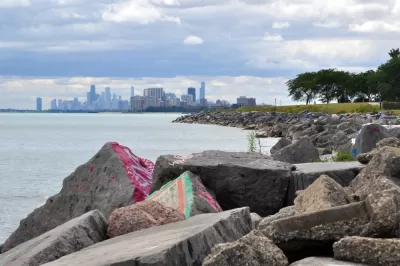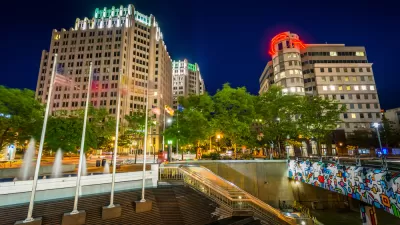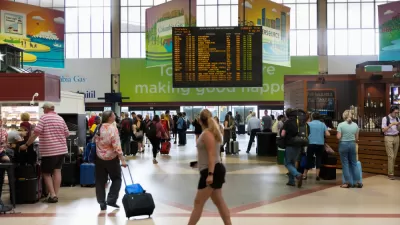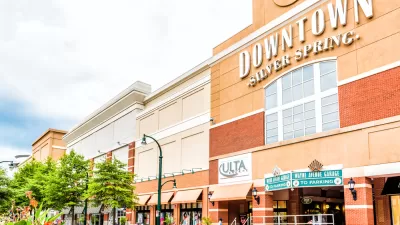A comprehensive review of the inner-ring suburb of Evanston, Illinois, outside Chicago, and a transformation Jane Jacobs would surely love. The proof is in the pudding: Evanston car ownership are far below regional averages.

"At first glance, downtown Evanston, Illinois, doesn’t look revolutionary—just another a gentrifying urban core with the obligatory Whole Foods, the local organic sustainable restaurants serving $14 cocktails, the towering new, high-end luxury apartments filled with stainless steel appliances and granite countertops," writes T.R. Goodman in a longread feature for Politico Magazine.
"It takes, in fact, a few extra minutes in the neighborhood to realize what’s different—and what’s missing. Downtown Evanston—a sturdy, tree-lined Victorian city wedged neatly between Lake Michigan and Chicago’s northern border—is missing cars. Or, more accurately, it’s missing a lot of cars. Thanks to concerted planning, these new developments are rising within a 10-minute walk of two rail lines and half-a-dozen bus routes. The local automobile ownership rate is nearly half that of the surrounding area."
Goodman traces the ideas upon which Evanston built that "concerted planning" to Jaime Lerner's example in Curitiba. Evanston adopted the Curitiba model, according to Goodman, in response to a decline that began in the 1950s as farther flung suburbs began to rack up successes. "Beginning in 1986, a new plan for Evanston embraced the idea of a '24/7' downtown, pouring resources into increasing the density of its downtown—a density that also meant decreasing residents’ reliance on automobiles. As a compact city, Evanston couldn’t compete with the vast sprawling parking spots of the Old Orchard Mall. It had to build a different sort of appeal," writes Goodman.
Explaining contemporary planning terms, inspired by Jane Jacobs and Jaime Lerner, like TOD, density, and mixed use Goodman notes that terms like those have become so mainstream. In fact, and cities all over the country have embraced these concepts:
"Today, more cities are embracing transit-oriented development and heralding it as an antidote to climate change, a cure for the anomie of our 'Bowling Alone' culture and an economic boon to cash-strapped local governments. From northeastern 'suburbs' like Arlington, Virginia, to western car-centric cities like Salt Lake to Dallas, local officials are pushing for mixed-use, high-density development within a few minutes walk of a transit line."
The article is a longread, so there is a lot more on the details of Evanston's zoning code, an explanation of the role of parking requirements in the creation of sprawl, the challenges facing a density-focused planning agenda, the still-powerful political support behind car-centric thinking, how Millennials figure into the whole redevelopment equation, and more.
FULL STORY: The Suburb That Tried To Kill the Car

Planetizen Federal Action Tracker
A weekly monitor of how Trump’s orders and actions are impacting planners and planning in America.

Congressman Proposes Bill to Rename DC Metro “Trump Train”
The Make Autorail Great Again Act would withhold federal funding to the system until the Washington Metropolitan Area Transit Authority (WMATA), rebrands as the Washington Metropolitan Authority for Greater Access (WMAGA).

The Simple Legislative Tool Transforming Vacant Downtowns
In California, Michigan and Georgia, an easy win is bringing dollars — and delight — back to city centers.

The States Losing Rural Delivery Rooms at an Alarming Pace
In some states, as few as 9% of rural hospitals still deliver babies. As a result, rising pre-term births, no adequate pre-term care and "harrowing" close calls are a growing reality.

The Small South Asian Republic Going all in on EVs
Thanks to one simple policy change less than five years ago, 65% of new cars in this Himalayan country are now electric.

DC Backpedals on Bike Lane Protection, Swaps Barriers for Paint
Citing aesthetic concerns, the city is removing the concrete barriers and flexposts that once separated Arizona Avenue cyclists from motor vehicles.
Urban Design for Planners 1: Software Tools
This six-course series explores essential urban design concepts using open source software and equips planners with the tools they need to participate fully in the urban design process.
Planning for Universal Design
Learn the tools for implementing Universal Design in planning regulations.
Smith Gee Studio
City of Charlotte
City of Camden Redevelopment Agency
City of Astoria
Transportation Research & Education Center (TREC) at Portland State University
US High Speed Rail Association
City of Camden Redevelopment Agency
Municipality of Princeton (NJ)





























